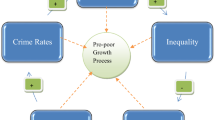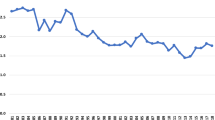Abstract
The objective of this study is to shed light on the determinants of criminality rates in Brazil. A panel data model was estimated using Brazilian states’ data. Our main result suggests that income inequality plays an important role in the determination of the crime rate. Furthermore, there are evidence suggesting that both unemployment and urbanization rates are positively related to crime. Based on a GMM approach we find the existence of an “inertial effect” on criminality. Besides that, the GMM results show that public security spending is effective in reducing criminality rates. Contrary to the common wisdom, we could not find evidence that poverty increases violent crimes. Finally, we have evidence that income inequality Granger causes crime, but not the reverse.
Similar content being viewed by others
References
Aghion P, Howitt P (1998) Endogenous Growth Theory. MIT Press, London
Andrade MV, Lisboa MB (2001) Mortalidade nos Estados do Rio de Janeiro, São Paulo e Minas Gerais. Estudos Econômicos São Paulo 31(1): 5–56
Arellano M, Bond S (1991) Some tests of specification for panel data: Monte Carlo evidence and an application to employent equations. Rev Econ Stud 58: 277–297
Arellano M, Bover O (1995) Another look at the instrumental variable estimation of error-components models. J Econom 68: 29–51
Baltagi BH (1995) Econometric analysis of panel data. Wiley, New York
Becker GS (1968) Crime and punishment: an economic approach. J Polit Econ 101: 169–217
Becker GS (1975) Human capital: a theoretical and empirical analisys. Columbia University Press, New York
Bénabou R (1996) Inequality and growth. NBER Macroeconomics Annual 11
Blundell R, Bond S (1998) Initial conditions and moment restrictions in dynamic panel data models. J Econom 87: 115–143
Blumstein A (1995) Touth violence, guns and the illicit-drug industry. J Crim Law and Criminol 86(4): 1175–1216
Blumstein A, Rosenfeld R (1998) Explaining recent trends in US homicide rates. J Crim Law Criminol 86(1): 10–36
Bond S (2002) Dynamic panel data models: a guide to micro data methods and practice. Working Paper 09/02. Institute for Fiscal Studies, London
Bourguinon F (1999) Crime as a social cost of poverty: a review focusing on developing countries. World Bank
Cano Ie, Santos N (2000) Uma Comparação das Fontes de Informação sobre Violência Letal. Mímeo. ISER
Card D (2001) Estimating the return to scooling: progress on some persistent econometric problems. Econometrica 69(5): 1127–1160
Daly M, Wilson M, Vasdev S (2001) Income inequality and homicide rates in Canada and the United States. Can J Criminol 43: 219–236
Durlauf NS (2001) A framework for the study of individual behavior and social interactions. Working Paper, Department of Economics, University of Wisconsin at Madison
Ehrlich I (1973) Participation in illegitimate activies: a theorical and empirical investigation. J Polit Econ 81: 521–565
Ehrlich I (1975) Deterrent effect of capital punishment: a question of life and death. Am Econ Rev 65(3): 397–417
Fajnzylber Pe, Araújo A Jr (2001) Violência e Criminalidade, em Microeconomia Aplicada no Brasil. Fundação Getúlio Vargas
Fajnzylber P, Lederman D, Loayza N (2000) What causes violent crime. Eur Econ Rev 46: 1323–1357
Fajnzylber P, Lederman D, Loayza N (1999) Inequality and violent crime. World Bank
Fleischer BM (1966) The effect of income on delinquency. Am Econ Rev 56: 118–137
Freeman RB (1994) Crime and Job Market. NBER Working Paper 4910
Freeman RB (1999) The economics of crime. In: Ashenfelter O, Card D (eds) Handbook of labor economis, vol 3
Freeman RB, Rodgers WM III (1999) Area economic conditions and the labor market outcomes of young men in the 1990s expansion. NBER Working Paper 7073, April
Glaeser EL, Sacerdote B (1999) Why is there more crime in cities. J Polit Econ 107(6): S225–S258
Glaeser EL, Sacerdote B, Scheinkman JA (1996) Crime and social interactions. Q J Econ 111: 507–548
Gould ED, Weinberg BA, Mustard DB (1979–1997) Crimes rates and local market opportunities in the United States
Granger C (1969) Investigating causal relations by econometric model and cross-spectral methods. Econometrica 37: 424–438
Greene W (1993) Econometric analisis. Prentice-Hall, Englewood Cliffs
Grogger J (1997) Local violence and educational attainment. J Hum Resour 32(4): 659–682
Hagan J, Petersen RD (1995) Crime and inequality. Stanford University Press
Holtz-Eakin D, Newey W, Rosen H (1988) Estimating vector autoregressions with panel data. Econometrica 56(6): 1371–1395
Hsiao C (2003) Analysis of panel data. Cambridge University Press, Cambridge
Imai S, Krishna K (2001) Employment, dynamic deterrence and crime. NBER Working Paper 8281
Judge G, Hill CW, Griffiths CW, Lee T, Lutkepol H (1985) Introduction to the theory and practice of econometrics. Wiley, New York
Kelly M (2000) Inequality and crime. Rev Econ Stat 82(4): 530–539
Kennedy B, Kawachi I, Prothrow-Stith D, Lochner K, Gupta RV (1998) Social capital, income inequality, and firearm violent crime. Soc Sci Med 47(1): 7–17
Levitt SD (1996) The effect of prison population size on crime rates: evidence from prison overcrowding litigation. Q J Econ 111: 320–351
Levitt SD, Venkatesh SA (1998) An economic analisis of drug-selling Gangs’s Finances. National Bureau of Economic Research Working Paper
Lochner SD (2001) A theorical and empirical study of individual perceptions of the criminal justice system. NBER Working PaperSeries
Loureiro PRA, Mendonça MJC, Sachsida A, Belquior T (2009) Crime, economic conditions, social interactions and family heritage. Int Rev Law Econ (forthcoming)
MacDonald Ziggy (2002) Official crime statistics: their use and interpretation. Econ J 112: F85–F106
Magalhães TA (1997) Desemprego e Crime—uma análise de séries temporais para o Distrito Federal: 1992–1996. Master Thesis, UNB, Department of Economics
Mendonça MJC, Loureiro PRA, Sachsida A (2002) Interaç ão Social e Crimes Violentos: uma análise empírica a partir do Presídio de Papuda. Estud Econ 32(4): 621–641
Merton R (1938) Social structure and anatomie. Am Sociol Rev 3: 672–682
Mincer J (1958) Investment in human capital and personal income distribution. J Polit Econ 66(4): 281–302
Pearsson T, Tabellini G (1998) Is inequality harmful for growth? Theory and evidence. Am Econ Rev 48: 600–621
Nair-Reicheit U, Weinhold D (2001) Causality tests for cross-country panels: new look at FDI and economic growth in developing countries. Oxf Bull Econ Stat 63(2): 151–171
Sachsida A, Mendonça MJC, Loureiro PRA (2008) Wage discrimination and place of residence. Braz J Appl Econ 12(3)
Soares JB (1999) Development, crime and punishment: accounting for the international differences in crime rates. Mimeo, Department of Economics, University of Chicago
Trumbull WN (1989) Estimating of the economic model of crime using aggregate and individual data level. South Econ J 56: 423–439
Witte AD, Witt R (2001) What we spend and what we get: public and provision of crime prevention and criminal justice. NBER Working Paper No. 8204
Wooldridge FM (2001) Econometric analysis of cross-section and panel data. MIT Press, New York
Author information
Authors and Affiliations
Corresponding author
Rights and permissions
About this article
Cite this article
Sachsida, A., de Mendonça, M.J.C., Loureiro, P.R.A. et al. Inequality and criminality revisited: further evidence from Brazil. Empir Econ 39, 93–109 (2010). https://doi.org/10.1007/s00181-009-0296-4
Received:
Accepted:
Published:
Issue Date:
DOI: https://doi.org/10.1007/s00181-009-0296-4




